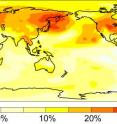CO2 effects on plants increases global warming
Trees and other plants help keep the planet cool, but rising levels of carbon dioxide in the atmosphere are turning down this global air conditioner. According to a new study by researchers at the Carnegie Institution for Science, in some regions more than a quarter of the warming from increased carbon dioxide is due to its direct impact on vegetation. This warming is in addition to carbon dioxide's better-known effect as a heat-trapping greenhouse gas. For scientists trying to predict global climate change in the coming century, the study underscores the importance of including plants in their climate models. "Plants have a very complex and diverse influence on the climate system," says study co-author Ken Caldeira of Carnegie's Department of Global Ecology. "Plants take carbon dioxide out of the atmosphere, but they also have other effects, such as changing the amount of evaporation from the land surface. It's impossible to make good climate predictions without taking all of these factors into account."
Plants give off water through tiny pores in their leaves, a process called evapotranspiration that cools the plant, just as perspiration cools our bodies. On a hot day, a tree can release tens of gallons of water into the air, acting as a natural air conditioner for its surroundings. The plants absorb carbon dioxide for photosynthesis through the same pores (called stomata). But when carbon dioxide levels are high, the leaf pores shrink. This causes less water to be released, diminishing the tree's cooling power.
The warming effects of carbon dioxide as a greenhouse gas have been known for a long time, says Caldeira. But he and fellow Carnegie scientist Long Cao were concerned that it is not as widely recognized that carbon dioxide also warms our planet by its direct effects on plants. Previous work by Carnegie's Chris Field and Joe Berry had indicated that the effects were important. "There is no longer any doubt that carbon dioxide decreases evaporative cooling by plants and that this decreased cooling adds to global warming," says Cao. "This effect would cause significant warming even if carbon dioxide were not a greenhouse gas."
In their model, the researchers doubled the concentration of atmospheric carbon dioxide and recorded the magnitude and geographic pattern of warming from different factors. They found that, averaged over the entire globe, the evapotranspiration effects of plants account for 16% of warming of the land surface, with greenhouse effects accounting for the rest. But in some regions, such as parts of North America and eastern Asia, it can be more than 25% of the total warming. "If we think of a doubling of carbon dioxide as causing about four degrees of warming, in many places three of those degrees are coming from the effect of carbon dioxide in the atmosphere, and one is coming from the direct effect of carbon dioxide on plants."
The researchers also found that their model predicted that high carbon dioxide will increase the runoff from the land surface in most areas, because more water from precipitation bypasses the plant cooling system and flows directly to rivers and streams. Earlier models based on greenhouse effects of carbon dioxide had also predicted higher runoff, but the new research predicts that changes in evapotranspiration due to high carbon dioxide could have an even stronger impact on water resources than those models predict.
"These results really show that how plants respond to carbon dioxide is very important for making good climate predictions," says Caldeira. "So if we want to improve climate predictions, we need to improve the representation of land plants in the climate models. More broadly, it shows that the kind of vegetation that's on the surface of our planet and what that vegetation is doing is very important in determining our climate. We need to take great care in considering what kind of changes we make to forests and other ecosystems, because they are likely to have important climate consequences."
The study is published in the May 3-7 online edition of the Proceedings of the National Academy of Sciences.
Source: Carnegie Institution
Other sources
- Sensitive sidefrom PhysorgWed, 5 May 2010, 22:01:44 UTC
- Surprise! Even Plants Can Contribute to Global Warmingfrom Live ScienceTue, 4 May 2010, 21:42:05 UTC
- CO2 effects on plants hikes global warmingfrom UPITue, 4 May 2010, 15:21:54 UTC
- Carbon dioxide's effects on plants increase global warming, study findsfrom Science DailyMon, 3 May 2010, 21:40:57 UTC
- CO2 effects on plants increases global warmingfrom Science BlogMon, 3 May 2010, 20:12:11 UTC
- CO2 effects on plants increases global warmingfrom PhysorgMon, 3 May 2010, 20:11:57 UTC
